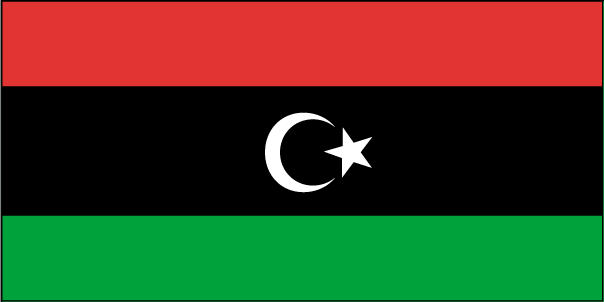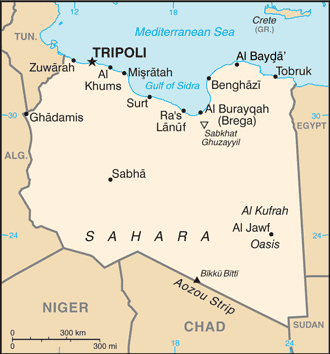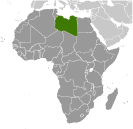
|
|
Advertisements:
People And SocietyNationality
Noun Libyan(s)
Adjective Libyan Ethnic groups
Berber and Arab 97%, other 3% (includes Greeks, Maltese, Italians, Egyptians, Pakistanis, Turks, Indians, and Tunisians) Languages
Arabic (official), Italian, English (all widely understood in the major cities); Berber (Nafusi, Ghadamis, Suknah, Awjilah, Tamasheq) Religions
Sunni Muslim (official) 97%, other 3% Population World Ranking: 109
5,613,380 (July 2012 est.)
Note Includes 166,510 non-nationals Age structure
0-14 years
32.8% (male 1,104,590/female 1,057,359) 15-64 years 62.7% (male 2,124,053/female 2,011,226) 65 years and over 4.6% (male 146,956/female 153,776) (2011 est.) Median age
Total 24.8 years
Male 24.8 years Female 24.7 years (2012 est.) Population growth rate World Ranking: 49
2.007% (2012 est.)
Birth rate World Ranking: 70
23.47 births/1,000 population (2012 est.) Death rate World Ranking: 211
3.41 deaths/1,000 population (July 2012 est.) Net migration rate World Ranking: 95
0 migrant(s)/1,000 population (2012 est.) Urbanization
Urban population 78% of total population (2010)
Rate of urbanization 2.1% annual rate of change (2010-15 est.) Major cities - population
TRIPOLI (capital) 1.095 million (2009) Sex ratio
At birth 1.05 male(s)/female
Under 15 years 1.04 male(s)/female 15-64 years 1.06 male(s)/female 65 years and over 0.96 male(s)/female Total population 1.05 male(s)/female (2011 est.) Maternal mortality rate World Ranking: 102
58 deaths/100,000 live births (2010) Infant mortality rate World Ranking: 99
Total 19.34 deaths/1,000 live births
Male 21.26 deaths/1,000 live births Female 17.33 deaths/1,000 live births (2012 est.) Life expectancy at birth World Ranking: 60
Total population 77.83 years
Male 75.5 years Female 80.27 years (2012 est.) Total fertility rate World Ranking: 110
2.12 children born/woman (2012 est.) Health expenditures World Ranking: 89
6.6% of GDP (2009)
Physicians density
1.9 physicians/1,000 population (2009) Hospital bed density
3.7 beds/1,000 population (2009) Hiv/aids - adult prevalence rate World Ranking: 81
0.3% (2001 est.)
Hiv/aids - people living with hiv/aids World Ranking: 95
10,000 (2001 est.)
Hiv/aids - deaths
NA
Children under the age of 5 years underweight World Ranking: 80
5.6% (2007)
Education expenditures
NA
Literacy
Definition
Age 15 and over can read and write Total population 89.2%Male 95.6% Female 82.7% (2010 est.) School life expectancy (primary to tertiary education)
Total 17 years
Male 16 years Female 17 years (2003)
Comments
Add a new comment: |
Advertisement
Members area
Libya (Tripoli):
 
GPS points from Libya (Tripoli)
|
||||||||

 The Italians supplanted the Ottoman Turks in the area around Tripoli in 1911 and did not relinquish their hold until 1943 when defeated in World War II. Libya then passed to UN administration and achieved independence in 1951. Following a 1969 military coup, Col. Muammar Abu Minyar al-QADHAFI began to espouse his own political system, the Third Universal Theory. The system was a combination of socialism and Islam derived in part from tribal practices and was supposed to be implemented by the Libyan people themselves in a unique form of "direct democracy." QADHAFI used oil funds during the 1970s and 1980s to promote his ideology outside Libya, supporting subversives and terrorists abroad to hasten the end of Marxism and capitalism. In addition, beginning in 1973, he engaged in military operations in northern Chad's Aozou Strip - to gain access to minerals and to use as a base of influence in Chadian politics - but was forced to retreat in 1987. UN sanctions in 1992 isolated QADHAFI politically following the downing of Pan Am Flight 103 over Lockerbie, Scotland. During the 1990s, QADHAFI began to rebuild his relationships with Europe. UN sanctions were suspended in April 1999 and finally lifted in September 2003 after Libya accepted responsibility for the Lockerbie bombing. In December 2003, Libya announced that it had agreed to reveal and end its programs to develop weapons of mass destruction and to renounce terrorism. QADHAFI subsequently made significant strides in normalizing relations with Western nations. The US rescinded Libya's designation as a state sponsor of terrorism in June 2006. In August 2008, the US and Libya signed a bilateral comprehensive claims settlement agreement to compensate claimants in both countries who allege injury or death at the hands of the other country, including the Lockerbie bombing, the LaBelle disco bombing, and the UTA 772 bombing. In October 2008, the US Government received $1.5 billion pursuant to the agreement to distribute to US national claimants, and as a result effectively normalized its bilateral relationship with Libya. The two countries then exchanged ambassadors for the first time since 1973 in January 2009. Libya in May 2010 was elected to its first three-year seat on the UN Human Rights Council, prompting protests from international non-governmental organizations and human rights campaigners. Unrest that began in several Near Eastern and North African countries in late December 2010 spread to several Libyan cities in early 2011. In March 2011, a Transitional National Council (TNC) was formed in Benghazi with the stated aim of overthrowing the QADHAFI regime and guiding the country to democracy. In response to QADHAFI's harsh military crackdown on protesters, the UN Security Council adopted Resolution 1973, which demanded an immediate ceasefire and authorized the international community to establish a no-fly zone over Libya. After several months of see-saw fighting, anti-QADHAFI forces in August 2011 captured the capital, Tripoli. In mid-September, the UN General Assembly voted to recognize the TNC as the legitimate interim governing body of Libya. The TNC on 23 October officially declared the country liberated following the defeat of the last remaining pro-QADHAFI stronghold and QADHAFI's death, and plans to transition toward elections, the formation of a constitution, and a new government.
The Italians supplanted the Ottoman Turks in the area around Tripoli in 1911 and did not relinquish their hold until 1943 when defeated in World War II. Libya then passed to UN administration and achieved independence in 1951. Following a 1969 military coup, Col. Muammar Abu Minyar al-QADHAFI began to espouse his own political system, the Third Universal Theory. The system was a combination of socialism and Islam derived in part from tribal practices and was supposed to be implemented by the Libyan people themselves in a unique form of "direct democracy." QADHAFI used oil funds during the 1970s and 1980s to promote his ideology outside Libya, supporting subversives and terrorists abroad to hasten the end of Marxism and capitalism. In addition, beginning in 1973, he engaged in military operations in northern Chad's Aozou Strip - to gain access to minerals and to use as a base of influence in Chadian politics - but was forced to retreat in 1987. UN sanctions in 1992 isolated QADHAFI politically following the downing of Pan Am Flight 103 over Lockerbie, Scotland. During the 1990s, QADHAFI began to rebuild his relationships with Europe. UN sanctions were suspended in April 1999 and finally lifted in September 2003 after Libya accepted responsibility for the Lockerbie bombing. In December 2003, Libya announced that it had agreed to reveal and end its programs to develop weapons of mass destruction and to renounce terrorism. QADHAFI subsequently made significant strides in normalizing relations with Western nations. The US rescinded Libya's designation as a state sponsor of terrorism in June 2006. In August 2008, the US and Libya signed a bilateral comprehensive claims settlement agreement to compensate claimants in both countries who allege injury or death at the hands of the other country, including the Lockerbie bombing, the LaBelle disco bombing, and the UTA 772 bombing. In October 2008, the US Government received $1.5 billion pursuant to the agreement to distribute to US national claimants, and as a result effectively normalized its bilateral relationship with Libya. The two countries then exchanged ambassadors for the first time since 1973 in January 2009. Libya in May 2010 was elected to its first three-year seat on the UN Human Rights Council, prompting protests from international non-governmental organizations and human rights campaigners. Unrest that began in several Near Eastern and North African countries in late December 2010 spread to several Libyan cities in early 2011. In March 2011, a Transitional National Council (TNC) was formed in Benghazi with the stated aim of overthrowing the QADHAFI regime and guiding the country to democracy. In response to QADHAFI's harsh military crackdown on protesters, the UN Security Council adopted Resolution 1973, which demanded an immediate ceasefire and authorized the international community to establish a no-fly zone over Libya. After several months of see-saw fighting, anti-QADHAFI forces in August 2011 captured the capital, Tripoli. In mid-September, the UN General Assembly voted to recognize the TNC as the legitimate interim governing body of Libya. The TNC on 23 October officially declared the country liberated following the defeat of the last remaining pro-QADHAFI stronghold and QADHAFI's death, and plans to transition toward elections, the formation of a constitution, and a new government.